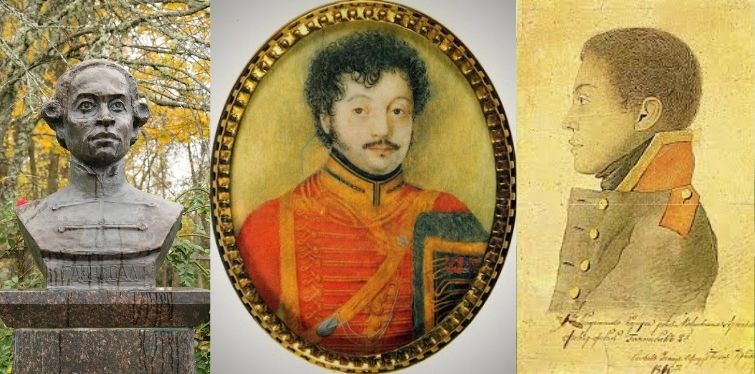Black Officers in the Russian army during the Napoleonic Wars
Most of the posts on this blog have focused on prominent figures and battles during the Napoleonic Wars. This post is somewhat different and is the product of some research into Russian online sources into black officers in the Russian army during the Napoleonic Wars.
The Imperial Russian Army of the early nineteenth century was a multinational and multiethnic organisation. The westward expansion of the Russian Empire in the 18th century brought Baltic Germans, Poles, Ukrainians, Finns into the ranks of officers and men. Russia’s wars in the Caucasus and the Balkans saw men of Georgian and Serbian origin join the ranks, most notably Prince Pyotr Bagration and Count Mikhail Miloradovich. There were also peoples of Central Asia – Kalmyks, Bashkirs, Kirghiz and Tatars among them, absorbed into the Russian Empire during its eastward expansion – who fought alongside the Cossacks as irregular cavalry.
In spite of the ethnic diversity of the Russian Empire, it would have been rare to see someone of African descent in 19th century Russia. Unlike western Europe, the Russian Empire was not involved in the Atlantic slave trade and had no colonial or commercial presence in Africa. Nevertheless, there was one particularly prominent African family in Imperial Russia: the Gannibals.

The Gannibals were descendants of Abram Petrovich Gannibal (c. 1697-1781), best known as the great-grandfather of Russia’s great poet Alexander Pushkin, and the subject of his unfinished novel 'The Moor of Peter the Great.' Gannibal claimed to have been an African prince who was captured and sold to the Ottomans, and alongside a younger brother who died soon afterwards, was presented to Peter the Great as a gift. Peter was fond of the young child and took him on campaign during the Great Northern War, before sending him to study in Paris.
Gannibal became a military engineer and would eventually be given noble status by Empress Elizaveta (Peter’s daughter) in 1742. After serving as Governor General of Reval (Tallinn), in 1759 he reached the rank of general-in-chief, just below field marshal but with similar duties on the field.
His eldest son Ivan (1735-1801) also reached the same rank, and participated in the Battle of Chesme of 1770 when a Russian fleet defeated the Turks. Ivan Gannibal is also regarded as the founder of the Ukrainian city of Kherson. Abram's second son, Pyotr Abramovich (1742-1826), also attained the rank of general-in-chief for the artillery. His third son Osip Abramovich (1744-1806) reached the rank of captain in the navy but is best known as Pushkin’s maternal grandfather.
This brings us to Abram Gannibal's youngest son, Isaak Abramovich (1747-1804), who was also a captain and naval gunner. Isaak was the father to at least fourteen children, six daughters and eight sons. As relatives of Pushkin, the Gannibals have been the subject of some research by Pushkin scholars and local historians of the Pskov region. In her book The Gannibals and Pushkin in the Pskov region published in 1999, Tatyana Maltseva includes biographical articles on most of Isaak’s children, but the book is not available digitally. I have therefore had to rely on more recent journal articles which build on Maltseva’s work and uncover new information.
Despite academic interest in the Gannibals, it is still remarkably difficult to pin down details of their lives and military service. Based on available information, it appears that four of Isaak’s sons saw action in the Napoleonic Wars: Pavel Isaakovich (1776-1841), Alexander Isaakovich (1788-1813), Dmitry Isaakovich (1789-18??), Semyon Isaakovich (1790-1853).
Pavel Isaakovich Gannibal (1776-1841)

Of all the Isaakovichi (the sons of Isaak Gannibal), we seem to know the most about Pavel Isaakovich Gannibal. His father sent him to the Naval Cadet Corps in 1791 and he served with the Baltic fleet from 1794. In 1799 he left the navy with the rank of lieutenant and transferred to a grenadier regiment, receiving the rank of army lieutenant in 1801 and later staff captain. He participated in the 1805 campaign and was present at the Battle of Austerlitz, for which he was promoted to captain in 1806. He left the army due to illness in 1808 but returned in 1809, now serving in the Lubensky Hussar Regiment, but once again left in 1810.
Following Napoleon’s invasion in June 1812, Gannibal was among the legions of Pskov nobles who joined the Pskov militia. However, this force was not involved in combat and its role was limited to ensuring that General Wittgenstein’s I Corps – defending the road to St Petersburg – was well-supplied. While carrying out his duties he appears to have been involved in a dispute with an officer of the Novgorod regiment which prompted him to voluntarily return to his estate. His younger brother Pyotr Gannibal (1785-1822) was also part of the Pskov militia and tasked with supplying Wittgenstein’s Corps.
This incident did not prevent Pavel Gannibal from joining the St Petersburg militia in December 1812 serving in the 1st Volunteer Regiment under the command of Novgorod landowner Alexander Yakhontov. Serving in the independent corps of General Friedrich (Fyodor) von Löwis, he took part in the pursuit of the remnants of the Grande Armée’s northern flank from Riga to Konigsberg. He was awarded a silver medal in commemoration of the 1812 campaign and the Order of St Vladimir 4th Class with the light blue ribbon of the Order of St Andrew.
He accompanied the Russian army during the campaigns of 1813-14, being present at the siege of Danzig. Commanding a squadron in the convoy of commander-in-chief General Wittgenstein, he distinguished himself at the Battle of Bautzen for which he was awarded the Order of St Anna 4th class. He was assigned to the Crown Prince of Sweden (Bernadotte)’s Army of the North in August and fought at Grossbeeren, Dennewitz, and Torgau, where he received the Order of St Anna 3rd class. Following the allied victory at the Battle of Leipzig (16-19 October 1813) he was promoted to major. He fought at the siege of Hamburg but was recalled to Russia before the allies took Paris. In April 1815 he was transferred to the Iziumsky Hussar regiment and accompanied the Russian army as it marched back to France but did not see any action.
He retired from the army in 1817 (other sources indicate 1821) but was not given a pension as he had not been wounded in battle. In 1817, the 17 year old Pushkin had recently graduated from the Tsarskoe Selo Lyceum and met his uncle Pavel for the first time. The two men got on well, but this didn’t stop the impetuous Pushkin from challenging him to a duel during a ball when Gannibal stole his dance partner from him. Ten minutes later the two reconciled after Gannibal composed an impromptu verse announcing he had no intention of spoiling the ball and threw his arms around his nephew.
In 1826, Gannibal was suspected of harbouring sympathies with the Decembrists and was arrested and sent to the Peter and Paul Fortress. After a two month investigation he was found guilty and initially exiled to the town of Solvychegodsk in the Vologda region for five months before being imprisoned at the Solovetsky monastery near the Arctic circle in 1827. His wife petitioned for his release in 1829 but this was only granted in 1832. He settled in Luga, around 100 miles south of St Petersburg. He wrote to Alexander Benckendorff, Head of the Third Section (secret police) that he was prepared to enter the Tsar’s service to prove his innocence, but the offer went unanswered. He died in poverty in 1841.
Alexander Isaakovich Gannibal (1788?-1813)
In contrast to Pavel, we know the least about Alexander Isaakovich. His article in Malsteva’s book on the Gannibals is less than a page long, judging from the book’s title page, and his dates are also unknown. In an article from 2013 in the journal Pskov under the title ‘A. A. Yakhontov and the Gannibals in 1813,’ Konstantin Zhuchkov cites General Joseph Galatte’s report of the Battle of Leipzig to his superior Count Joseph O’Rourke, in which he writes that “according to the report from the 1st Volunteer Regiment, cornet Gannibal was killed…”
Zhuchkov concludes through a process of elimination that the Gannibal in question must be Alexander Isaakovich, whom he suggests was born around 1788. This indicates that Alexander had served in the ranks of the 1st Volunteer Regiment alongside his brother Pavel and presumably participated in the same battles as his brother before he was killed at the 'Battle of the Nations' in Leipzig.
Dmitry Isaakovich Gannibal (1789-18??)
Information about Dmitry Isaakovich Gannibal is also hard to come by. His biographical article in Maltseva’s book runs to three pages but his dates are not complete. In a brief article in Pskov journal Issue No. 39 from 2013, Konstantin Zhuchkov presents three archival documents associated with Dmitry Isaakovich’s discharge from military service.
One of these documents cites Dmitry Isaakovich’s service record, showing that he graduated from the 1st Cadet Corps and joined the 7th artillery brigade as a sub-Lieutenant in 1809, and served with them in 1812, fighting at the (Second) Battle of Krasny (15-18 November), during which Kutuzov’s main army inflicted a major defeat on Napoleon’s retreating Grande Armée. The 7th artillery brigade, attached to the 7th Infantry Division, was part of General Dmitry Dokhturov’s VI Corps which fought at Smolensk and Borodino. As there is nothing to suggest that Gannibal was at these battles, Zhuchkov surmises that Gannibal must have been part of the 7th reserve artillery brigade. This seems equally unlikely, as this brigade had been part of Chichagov’s Army of the Danube and presumably would have fought in the Turkish War. It is also unclear how the unit could have joined the main army to fight at Krasny.
There is no further record of Dmitry Gannibal’s participation in the battles of the 1813-14 campaigns, although it appears that he was transferred to the 17th light company of the 9th artillery brigade in June 1813. In June 1815, he left the army due to illness which confined him to a military hospital in Warsaw until January 1816, but the discharge was not formalised until 1820.
Semyon Isaakovich Gannibal (1790-1853)

Born around 1790, Semyon Isaakovich Gannibal appears to have been the youngest of the Isaakovichi (though Maltseva places Dmitry's birth in 1793). He enrolled in the 1st Cadet Corps in 1798 and graduated in 1807. Citing Maltseva, V.I. Nikiforov in his article Relatives and Pskov friends of A.S. Pushkin – participants of the 1812 war in Pskov Issue No. 36 (2012) suggests that Gannibal fought at the First Battle of Krasny (14 August 1812) as part of Dmitry Neverovsky’s 27th Division. Aleksandr Kozmin in an article titled The Gannibals, participants of the Patriotic War of 1812 in memoirs, academic and literary sources, referring to a service record dating from 1818, states that Semyon Gannibal was assigned to the 1st Depot Artillery Brigade in 1811 which became part of Bagration’s Second Army. Kozmin goes on to write that he fought at the Second Battle of Krasny.
While three companies of the 1st Depot Artillery Brigade was assigned to General Wittgenstein’s I Corps, the fate of the remainder is unclear. Since these ‘depot brigades’ were intended to replenish field and reserve units, it is unlikely that Semyon Gannibal would have participated at the First Battle of Krasny. It is also clear that if he served under Prince Bagration, he would have fought at Borodino. Based on the available information, it is more likely that – like his brother Dmitry – Semyon Gannibal did not see action until November and Second Krasny. His participation in the 1813-14 campaigns is unclear, though Kozmin writes that he accompanied the army on campaign in 1815.
According to Maltseva, he retired from the army with the rank of lieutenant before 1830 and entered the civil service. In 1833 he appears as a civil servant of the 12th class, serving as an assistant at the Commissariat Department of the War Ministry working on veterans’ affairs. In 1835 he married Olga (or Anna) Pavlovna Kuvaeva, with whom in 1849 he had a daughter, Anna Semyonovich Gannibal, later a writer and historian. In the 1840s he was the manager of several noble estates, and he died in 1853 at Count Apraksin’s estate of Dobrodeevka (now part of Bryansk oblast) in the Chernigov region.



Share and get 15% off!
Simply share this product on one of the following social networks and you will unlock 15% off!